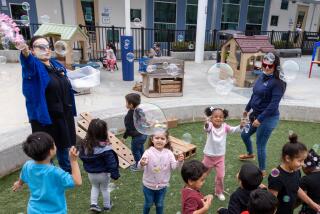Asking Right Questions Is Vital to Choosing Best Preschool
When choosing a preschool for your child, look critically at the artwork on the walls.
âIf you have all pink bunnies with little white cotton tails, youâre in trouble,â says Jackie Haines of the Gesell Institute of Human Development in New Haven, Conn. âSomebodyâs going to do a blue bunny with a green tail.
âAnd thatâs perfectly fine,â Haines says. âIâve seen blue bunnies with green tails.â
Allowing for childrenâs individual differences--in social style, in intellectual approach, in artwork--is critical for a good preschool experience, says Haines, coordinator of the instituteâs national lecture staff and an educator and guidance counselor.
But parentsâ agendas for their childrenâs preschool education are frequently at odds with what is best--and different--from childrenâs concerns, says Haines, who lectured on the topic recently as part of the instituteâs âParenting Your Preschoolerâ series.
âFor children, the whole impact of coming to school is, âWill the kids like me? Will the teacher like me? Is this going to be a safe place?â â
âWhen you think about some of the issues that adults have for children, that can seem almost foreign,â she says. Most adults want to know, âWhat do you learn? How soon is the reading going to come? Do you do phonics? Do you have workbooks? Is my child going to be ready for kindergarten?â
Inappropriate, Haines stresses.
âWhat you want in a preschool is that the basic philosophy is to help the youngsters feel secure about themselvesâ--promoting a good self-image and teaching how to cope with problems, Haines says. Schools that are pushing academics and ditto-sheet exercises at preschoolers have a fundamentally wrong approach, she says.
Parents who ask the right questions and look for the right things when selecting a preschool will do much to foster a positive attitude toward school and learning in the later years, Haines says. Some of her suggestions:
* Ask whether the school is licensed.
* Look to see how much of the school âbelongs to the children.â The equipment and layout should facilitate childrenâs play, not be convenient for adults.
* Find out if the staff is knowledgeable about child development.
* Make sure there are things for the children to climb on, spaces for them to play in and equipment for them to use that stimulates motor skills. As children have become more sedentary, it has been learned that development of fine motor skills, such as the ability to cut accurately with scissors, is dependent upon adequate development of gross motor skills, such as climbing.
âWhat you should see is lots of mucking-about stuff,â Haines says. âEasels, real chalkboards where you can get in there with a large piece of chalk and stimulate large muscles.â
But there should not be so much equipment that it overstimulates the children.
* Ask the teachers how they handle conflicts between children. Teachers should help children work out disputes themselves. If there is a âtime-out chair,â find out how it is used. Haines thinks isolating a child in a chair in the corner is inappropriately punitive. If the school does use this technique, better it be a rocking chair where the child can sit for a few minutes while getting tender attention from a teacher, she says.
* Watch to see how astute teachers are in listening to children. âWhen a youngster has an idea, are they open, or are they always trying to impose their own view?â
* Check the teacher-children ratio. âOptimum learning is dependent on childrenâs manipulation, experimentation, questioning and communication,â Haines says. You want enough staff to be available for childrenâs conversations and questions. For 3-year-olds, there should be no more than five children to a teacher; for 4-year-olds, eight to a teacher is good; for 5-year-olds, no more than 15 children, she says.
* The schedule should include lots of reading to the children, music (âand not only little-children songsâ) and an emphasis on drama.





